Even in the quietest parts of winter, our local chalk streams hum with activity. As coots and moorhens glide across the surface, one of their relatives may be hiding in plain sight. At around 23-28cm long, the water rail is smaller than these more outgoing members of the Rallidae family, but just as fond of damp places. Ponds, marshes, reedbeds, wetlands, and rivers can all be homes for this enigmatic bird.
One reason for the water rail’s wide variety of habitats is its omnivorous diet. Although it mostly eats fish, snails, and insects, it will also snack on roots, seeds, and berries. There are even reports of water rails catching small amphibians, mammals, and birds. With its long legs, long toes, and long beak, this species is perfectly adapted for hunting and foraging on boggy ground or in shallow water.
Pictured below from left to right (click to expand): Water rail with juvenile colouring / Water rail with adult colouring.





